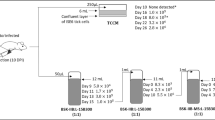Abstract
Barbour-Stoenner-Kelly (BSK) II medium containing fosfomycin, 5-fluorouracil, trimethoprim and sulfamethoxazole was evaluated for the selective isolation of theBorrelia species responsible for Lyme disease and relapsing fever. The maximum noninhibitory concentrations of fosfomycin, 5-fluorouracil, trimethoprim and sulfamethoxazole for six strains of borreliae were 500 to >1000 µg/ml, 250 to >500 µg/ml, 125 to 500 µg/ml and 125 to 500 µg/ml, respectively. The combination of four agents (fosfomycin 400 µg/ml, 5-fluorouracil 100 µg/ml, trimethoprim 10 µg/ml, sulfamethoxazole 50 µg/ml) did not inhibit the growth of borreliae, allowing growth in cultures inoculated with a few organisms (theoretically a single organism). In contrast, the fouragent combination completely inhibited the growth of 12 of 13 other bacterial strains tested as possible contaminants. This combination also allowed the selective growth of borreliae in experimentally contaminated specimens. The four-agent combination in BSK II medium may be useful for selective isolation ofBorrelia species responsible for Lyme disease and relapsing fever from clinical and environmental samples.
Similar content being viewed by others
References
Barbour AG: Isolation and cultivation of Lyme disease spirochetes. Yale Journal of Biology and Medicine 1984, 57: 521–525.
Barbour AG, Burgdorfer W, Hayes SF, Peter O, Aeschlimann A: Isolation of a cultivable spirochete fromIxodes ricinus ticks of Switzerland. Current Microbiology 1983, 8: 123–126.
Kelly R: Cultivation ofBorrelia hermsii. Science 1971, 173: 443–444.
Preac-Mursic V, Wilske B, Schierz G: EuropeanBorrelia burgdorferi isolated from humans and ticks: culture conditions and antibiotic susceptibility. Zentralblatt für Bakteriologie, Mikrobiologie und Hygiene (A) 1986, 263: 112–118.
Åsbrink E, Hovmark A, Hederstedt B: The spirochetal etiology of acrodermatitis chronica atrophicans Herxheimer. Acta Dermato-Venereologica 1984, 64: 506–512.
Burgdorfer W, Gage KL: Susceptibility of the hispid cotton rat (Sigmodon hispidus) to the Lyme disease spirochete (Borrelia burgdorferi). American Journal of Tropical Medicine and Hygiene 1987, 37: 624–628.
Burgdorfer W, Lane RS, Barbour AG, Gresbrink RA, Anderson JR: The western black-legged tick,Ixodes pacificus: a vector ofBorrelia burgdorferi. American Journal of Tropical Medicine and Hygiene 1985, 34: 925–930.
Neubert U, Krampitz HE, Engl H: Microbiological findings in erythema chronicum migrans and related disorders. Zentralblatt für Bakteriologie, Mikrobiologie und Hygiene (A) 1986, 263: 237–252.
Steere AC, Grodzicki RL, Kornblatt AN, Craft JE, Barbour AG, Burgdorfer W, Schmid GP, Johnson E, Malawista SE: The spirochetal etiology of Lyme discase. New England Journal of Medicine 1983, 308: 733–740.
Johnson SE, Klein GC, Schmid GP, Bowen GS, Feeley JC, Schulze T: Lyme disease: a selective medium for isolation of the suspected etiological agent, a spirochete. Journal of Clinical Microbiology 1984, 19: 81–82.
Oie S, Koshiro A, Konishi H, Yoshii Z: In vitro evaluation of combined usage of fosfomycin and 5-fluorouracil for selective isolation ofLeptospira species. Journal of Clinical Microbiology 1986, 23: 1084–1087.
Miyamoto K, Nakao M, Sato N, Mori M: Isolation of Lyme disease spirochetes from an ixodid tick in Hokkaido, Japan. Acta Tropica 1991, 49: 65–68.
Turner LH: Leptospirosis. III: Maintenance, isolation and demonstration of leptospires. Transactions of the Royal Society of Tropical Medicine and Hygiene 1970, 64: 623–646.
MacFaddin JF: Media for isolation-cultivation-identification-maintenance of medical bacteria. Volume 1. Williams and Wilkins. Baltimore, 1985, p. 796–797.
Barbour AG: Laboratory aspects of Lyme borreliosis. Clinical Microbiology Reviews 1988, 1: 399–414.
Author information
Authors and Affiliations
Rights and permissions
About this article
Cite this article
Morshed, M.G., Konishi, H., Nishimura, T. et al. Evaluation of agents for use in medium for selective isolation of lyme disease and relapsing feverBorrelia species. Eur. J. Clin. Microbiol. Infect. Dis. 12, 512–518 (1993). https://doi.org/10.1007/BF01970956
Issue Date:
DOI: https://doi.org/10.1007/BF01970956




